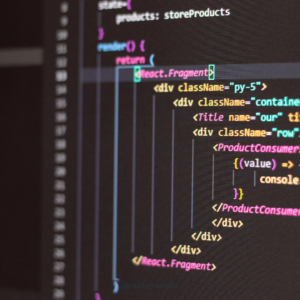Why Startups and Enterprises Prefer...
April 10, 2025

Enter the thrilling world of software development, where unlimited options abound and creativity abounds. Python, a powerful tool that has captured the attention of developers worldwide, has sparked a new era of coding brilliance in the ever-changing digital landscape.
Python development is a versatile and strong programming language that is reshaping the programming landscape. Python, with its versatility, scalability, and endless potential, is unstoppable, attracting programmers and moving us toward an awesome future.
Prepare for an exciting voyage as we investigate why Python is destined to be the driving force behind technological developments in the future. So strap on and get ready for a trip that unveils the true essence of Python’s importance and the incredible things it can help us do.
Python has become famous because it has some really great features.
Python’s quick climb to prominence can be attributed to its unique features that distinguish it from other programming languages. Its simple syntax, extensive library ecosystem, adaptability, and emphasis on readability have made it a favorite among developers all around the world. Python’s popularity is likely to skyrocket as it continues to expand and adapt to new trends, solidifying its status as one of the most significant programming languages of our time.
Here are some of the key factors that have contributed to Python’s fame:
Clean and Clear Syntax: Python’s syntax is intended to be straightforward and easy to grasp. It defines code chunks with indentation, which increases readability and ensures consistent formatting. This eliminates the need for superfluous brackets or semicolons, decreasing visual clutter and making the code more visually pleasing.
File and Directory Operations: The os module contains utilities for interacting with files, directories, and the operating system. It lets you alter paths, create and delete folders, conduct file I/O operations, and do other things.
Data Analysis and Scientific Computing: Python Development has grown in popularity as a data analysis and scientific computing language, owing mostly to modules such as NumPy, Pandas, and SciPy. NumPy delivers robust numerical processing capabilities, Pandas provides high-performance data manipulation and analysis tools, and SciPy offers a diverse set of scientific and engineering tasks. Python has become the go-to language for data scientists and academics thanks to these libraries and visualization tools like Matplotlib and Seaborn.
Machine Learning and Artificial Intelligence: Python’s environment places a strong emphasis on machine learning and artificial intelligence. TensorFlow, Keras, PyTorch, and sci-kit-learn libraries provide solid frameworks for constructing and deploying machine learning models. These libraries provide a diverse set of algorithms, tools for model training and evaluation, and deep learning support. Python’s expressive syntax and simplicity make it an ideal language for developing machine learning algorithms and working with enormous datasets.
C/C++ Integration: Python provides interfaces and tools to easily integrate with C and C++ code. Developers can write extensions in C or C++ and use them in Python programs using Python’s C API or third-party libraries like Cython or ctypes.
Frameworks and APIs: Python’s extensibility is improved further by the availability of frameworks and APIs that allow developers to extend current functionality. Django, Flask, and TensorFlow, for example, provide a basis for constructing web apps, APIs, and machine learning models.

Examining the Statistics: The Popularity of Python
Clear and Readable Syntax: Python’s syntax is intended to be highly readable and simple. It delimits code blocks with indentation and whitespace, making the code structure visually beautiful and easy to read. Python also avoids using complex symbols and superfluous punctuation, yielding code that closely resembles natural English. This clarity improves Python code readability and minimizes the likelihood of errors or confusion.
Easy to Learn and Understand: Python’s ease of use makes it an excellent language for novices. The straightforward and accessible syntax lowers the barrier to entry, making it easier for newbies to grasp programming ideas. Python’s emphasis on simplicity, paired with its vast documentation and helpful community, provides a gentle learning curve for beginners.
Continuous Development: Python’s community is continually working to improve and evolve the language. Python is developed and maintained by the Python Software Foundation (PSF), a non-profit organization. Python receives regular updates and new versions to address issues, bring new features, and improve efficiency. Developers regularly participate in debates and contribute to the Python Enhancement Proposal (PEP) process, and community feedback is critical in influencing the language’s future.
Events and Conferences: The Python community organizes a plethora of events, conferences, and meetups all over the world. These events allow developers to network, learn from professionals, and remain up to date on the newest advancements in the Python ecosystem. PyCon brings together Python fans from all backgrounds to create a venue for information sharing, collaboration, and community building.
Python is unquestionably positioned to be one of the main programming languages in the near future.
Its versatility, simplicity, and large library have made it popular among developers in a variety of fields.
Python’s diverse set of applications, ranging from web development to data analysis to machine learning and artificial intelligence, contributes to its expanding popularity.
Furthermore, its big and active community is constantly improving the language, making it more powerful and user-friendly.
Python’s significant presence in developing technologies, as well as its emphasis on readability and productivity, make it an appealing choice for both novices and experienced programmers, implying a promising future.
Conclusion
Python is an excellent choice for developers working in a variety of fields. Its lively and energetic community constantly improves the language, assuring its continued growth and progress.
Python’s strong presence in evolving technologies, as well as its emphasis on readability and productivity, make it an appealing choice for both new and experienced programmers. Python, with its boundless potential and ongoing innovation, is set to impact the future of programming and drive technological progress.